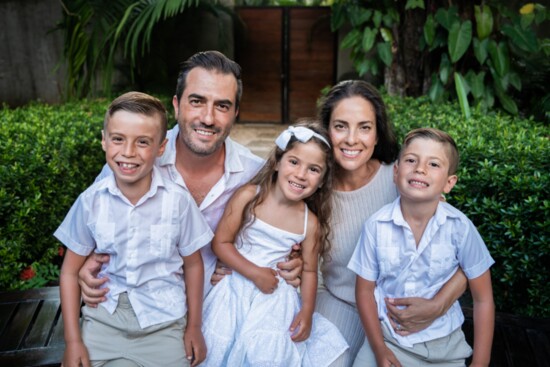I was on my way to a stable career in law when Julio convinced me to pursue filmmaking. We got married right out of college, and after several years trying to break into the industry, we finally scraped together enough financing to make our first film, The Vessel, in 2013. The film is about a small coastal village whose only school is destroyed by a tidal wave while all the children are inside. Julio scouted the entire island of Puerto Rico and settled on a shanty town outside Old San Juan called La Perla.
Before La Perla became famous in the popular music video “Despacito,” tourists were strongly deterred from visiting the town. Two years before we arrived, a massive raid sent many drug traffickers to jail, but still even the locals dared not go in. The first time Julio went to take photos, a resident warned him to leave immediately.
Thankfully, we made contact with the community leaders in La Perla and received their blessing. I knocked on every door of the community and introduced ourselves. It was a total family affair. Julio was the writer, director, set painter, and construction labor. His brother Alex was the engineer of “the vessel” that could sink and float on command, behind-the-scenes videographer, water effects supervisor, and stunt double for their other brother Lucas, who acted in the lead role. I was the producer, location scout, extras casting coordinator, and general community problem solver.
One week, our art department built an elementary school playground and the local children played on it for hours. In the story, the playground was destroyed by a wave, so our art department spent the evening taking hammers to it. The next day, the entire community was up in arms over the destruction. “We’ll find the people who did this to you!” they exclaimed. Someone offered to break some legs.
We quickly assured them, “It was us!” and everyone had a good laugh. We’ll never forget the experience of making our first film, when we would run around an infamous slum in the middle of the night just to get a movie made.
By the time we made our second film, Blue Miracle, six years later, we had three kids, including a three-month-old daughter. This time we were in the Dominican Republic, where they have a giant infinity tank next to the ocean for filming boat scenes without the mal de mer. The tank is in Juan Dolio, a quiet beach town where Santo Domingo locals escape on the weekends. We were on island time again.
We took a family posse with us to help with the kids while we worked 14 to 18-hour days. Our transportation department took on the critical role of delivering the milk I pumped on set to my baby back at the apartment. It was the hardest thing we have ever done, and we agonized about the little time we spent with our children. When we moved to Casa de Campo in La Romana to film our scenes at the marina, Julio’s parents took the kids to Punta Cana, one of the most pristine beaches in the world. In the two months we lived there, Julio and I never went to the beach once. The kids will have to show us around when we go back for vacation.
For our latest film, The Long Game, we returned to my home country of Colombia in the summer of 2022. It seemed to rain every day at 4 p.m. in Bogotá. This caused problems trying to stay on schedule but also made everything very, very green. This was perfect for the golf course scenes, but not so much for the scenes supposedly set in the desert brush country of Del Rio, Texas. During post-production, Julio spent a lot of time dialing Colombia to yellow.
We also had to paint out a few mountains, although every Colombian who has seen the film can still recognize their landscape. Unfortunately, residents from San Felipe and Del Rio, where the story is based, could also tell we didn’t film there. They quickly understood our explanation that Del Rio is too modernized now, so for the Texas neighborhood scenes we chose Smithville, Texas, which has mostly preserved its 1950s aesthetic. They weren’t quite so forgiving about our changing their school colors from purple and gold.
We’re not sure where the next project will take us. The nature of this industry is that we never know which project in development will get the green light first. What we do know is that Dripping Springs will always remain the comforting embrace of home.
Dripping Springs’ very own movie producer Marla Quintana takes us on a journey around the world with a behind-the-scenes look at the real adventures of creating feature films.
